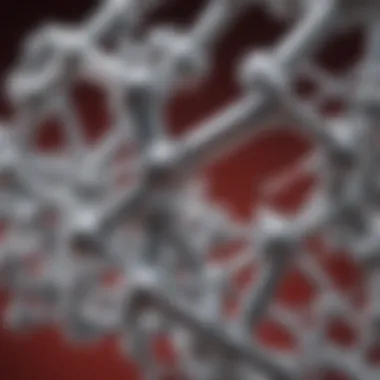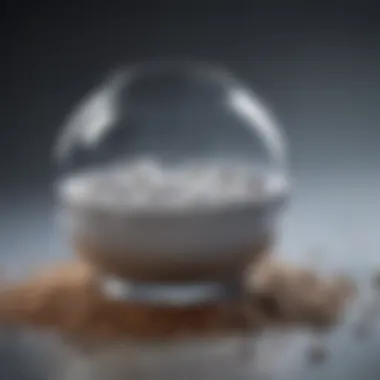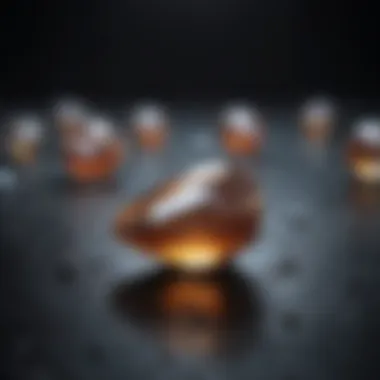Exploring the Impact of Titanium Dioxide Colour


Intro
Titanium dioxide, commonly known as TiO2, serves as a critical pigment in a wide range of industries due to its unique properties. This white pigment is celebrated for its opacity and brightness, making it a popular choice in paints, coatings, plastics, and even food products. However, its application goes beyond aesthetics, as it also plays a functional role in various chemical processes. Understanding the chemical mechanics and applications of titanium dioxide is essential, not only to appreciate its benefits but also to navigate the environmental concerns surrounding its use.
The discourse around titanium dioxide today is complicated by regulatory challenges and emerging alternatives that seek to address sustainability issues. As industries shift towards greener practices, it is crucial to evaluate both the advantages and potential drawbacks of TiO2. This exploration aims to furnish a comprehensive overview of the subject, informing practitioners in fields such as material science, environmental studies, and product manufacturing.
Foreword to Titanium Dioxide
Titanium dioxide is a compound that plays a crucial role in modern industries, acting as both a pigment and a functional additive. It is essential to understand its properties, applications, and implications to appreciate its significance in various sectors. The analysis of titanium dioxide provides insights into how it affects color, durability, and overall product quality.
Historical Context and Discovery
Titanium dioxide was first discovered in the 18th century. Sir William Gregor identified it in 1791 while examining the mineral ilmenite in Cornwall, England. This discovery led to further research on titanium and its oxides. Over the years, titanium dioxide became popular in many products, including paints and coatings, thanks to its excellent color characteristics and stability.
As demand grew, its applications expanded, marked by the introduction of the Rutile form in the 1940s. It was recognized for its superior whiteness and hiding power, making it a preferred choice in various formulations.
Chemical Composition and Structure
Titanium dioxide has three primary crystalline forms: anatase, rutile, and brookite. Each form possesses distinct properties that influence its applications.
Anatase Form
Anatase is a tetragonal modification of titanium dioxide. It is known for its high refractive index and strong light-scattering ability, making it effective as a pigment. The anatase form excels in its application in coatings due to its ability to enhance brightness and color quality.
One key characteristic of anatase is its photocatalytic activities. This unique feature allows it to break down organic pollutants when exposed to light. However, its lower chemical stability compared to rutile means that it may not be as beneficial in all situations.
Rutile Form
Rutile is the most stable and commonly used form of titanium dioxide. It exhibits a higher refractive index and superior brightness, which makes it highly sought after for applications that require excellent opacity. Its key characteristic lies in its durability and resistance to fading, making it essential in outdoor applications such as paints and coatings.
The rutile form is a beneficial choice for high-performance applications. However, its production can be more expensive than that of anatase, which may limit its use in lower-cost applications.
Brookite Form
Brookite is less common and less studied than its counterparts. This orthorhombic form of titanium dioxide features distinctive properties, which can be advantageous in specialized applications. Although brookite is less stable than rutile, it has unique electrical and optical properties that allow for innovative uses in electronics and optics.
A notable characteristic of brookite is its ability to be synthesized in nanocrystalline form. This unique feature gives it potential in advanced technologies, although its commercial applications remain limited due to availability.
Properties of Titanium Dioxide Colour
The properties of titanium dioxide (TiO2) colour play a crucial role in its effectiveness and usability across various industries. Understanding these characteristics is essential for optimizing its applications, especially in paints, coatings, plastics, and food products. The colour properties contribute to aesthetic appeal, functional performance, and overall sustainability of the materials involved. Various factors, like optical, physical, and chemical properties, significantly influence the performance of TiO2 in practical applications. This section provides a detailed analysis of the significant properties, emphasizing their importance and implications.
Optical Properties
Optical properties are fundamental for determining how titanium dioxide interacts with light. These properties affect how the pigment appears in products and influence broader applications in art and industry.
Light Scattering
Light scattering refers to the ability of TiO2 particles to scatter incoming light. This scattering effect is key because it contributes to the brightness and opacity of paints and coatings. TiO2 demonstrates a high refractive index, making it excel at scattering light.
- Key Characteristic: The high scattering efficiency helps create vivid white tones.
- Benefits: The effective scattering makes it a popular choice for various applications.
- Unique Feature: TiO2 can create thicker coatings with fewer materials.
However, there are some considerations. Fine particle sizes might enhance scattering but can also increase production costs.
Reflectance Characteristics
Reflectance characteristics describe how effectively titanium dioxide reflects light. These characteristics are critical in applications where brightness matters, such as paint or cosmetic products. TiO2 offers excellent UV reflectance, thus enhancing product longevity and protecting underlying surfaces.
- Key Characteristic: The high reflectance contributes to brighter colours.
- Benefits: Greater reflectance allows for lower pigment loadings.
- Unique Feature: Reflectance stability over time is a significant advantage in consumer products.


However, if the surface finish is not smooth enough, reflectance can degrade. This highlights the need for careful formulation in product design.
Physical Properties
Physical properties of titanium dioxide are also significant, influencing functionality and performance in various applications. Understanding these attributes helps in choosing the right type of TiO2 for specific needs.
Particle Size Distribution
Particle size distribution of TiO2 affects its performance in applications. Smaller particles tend to provide better coverage and opacity, while larger particles might deliver better scattering.
- Key Characteristic: A controlled particle size can optimize performance across different applications.
- Benefits: Proper distribution allows for uniformity in colour and texture.
- Unique Feature: Different size distributions can alter the final appearance of the product.
Nonetheless, achieving the desired particle size can require advanced manufacturing techniques, which can increase costs.
Surface Area Characteristics
Surface area characteristics impact the interaction of titanium dioxide with other substances. A higher surface area can enhance dispersibility, leading to better integration in matrices like paints and plastics.
- Key Characteristic: A larger surface area contributes to higher reactivity, improving pigment performance.
- Benefits: This feature aids in pigment stability and ensures uniform distribution.
- Unique Feature: It can impact the gloss or matte finish of the final product.
However, an excessively high surface area can lead to issues such as increased dust formation during handling, which necessitates careful consideration in production practices.
Chemical Stability
Chemical stability pertains to how titanium dioxide retains its properties over time under various conditions. Stability is vital for maintaining efficacy in long-term applications.
TiO2 is known for its resistance to photodegradation, ensuring longevity in products subjected to light exposure. This attribute makes it valuable in outdoor applications.
"The chemical stability of titanium dioxide ensures that its properties remain consistent over extended use, enhancing its utility in many industries."
Both thermal and chemical resilience can make TiO2 suitable for mixed products, preventing undesirable reactions with other materials. However, it's essential to monitor its stability in extreme conditions to ensure product performance.
Applications of Titanium Dioxide Colour
The applications of titanium dioxide (TiO2) colour span a variety of industries, illustrating its critical importance and versatility. Understanding where and how titanium dioxide is used highlights not only its functionality but also the benefits it offers to these sectors. The pigment is well-regarded for its strong opacity, brightness, and ability to enhance the aesthetic qualities of products. As a widely-utilized compound, TiO2 colour bears implications for performance across paints, plastics, cosmetics, and food products.
In Paints and Coatings
Durability
Durability is a pivotal aspect of titanium dioxide in paints and coatings. The compound provides excellent resistance to weathering, chemicals, and UV radiation. This resilience ensures longevity, preserving the integrity of the paint over time. Its high durability makes TiO2 a popular choice for outdoor applications, where exposure to the elements is significant. The unique feature of durability in TiO2 enhances the lifespan of painted surfaces, thus reducing the need for frequent reapplication.
Color Quality
The color quality of titanium dioxide is another significant factor. It achieves a high degree of whiteness and brightness, making it an ideal choice for a variety of applications. The exceptional color quality of TiO2 allows for vibrant and true-to-tone finishes. This aspect is particularly beneficial in industries where accurate color representation is critical. However, balancing brightness with other color attributes can be a challenge, requiring careful formulation in products.
In Plastics
UV Protection
In the context of plastics, titanium dioxide plays an important role in UV protection. It acts as a physical barrier against harmful UV rays, thereby reducing the risk of degradation. This UV blocking characteristic is essential for products exposed to sunlight. As a result, TiO2 contributes to maintaining the appearance and structural integrity of plastics over time. The ability to prevent damage from UV exposure makes it a sought-after ingredient in the plastics industry.
Aesthetic Appeal
Aesthetic appeal is greatly influenced by the use of titanium dioxide in plastics. Its whitest form provides a base for various colors, enhancing visuals in consumer products. The glossy finish that TiO2 imparts can elevate the perceived value of products. However, achieving the desired aesthetic while also ensuring functionality can be complex. The balance between look and durability is a consideration in using this pigment.
In Cosmetics
Safety and Efficacy
Safety and efficacy are paramount in cosmetics, and titanium dioxide meets these standards effectively. It is widely recognized for its non-toxic characteristics, making it suitable for various cosmetic formulations. Its properties help provide a natural UV filter, which enhances skin protection in sun care products. Consumers and manufacturers alike appreciate the safety profile of TiO2 as it meets stringent guidelines for personal care ingredients. However, ongoing research is necessary to fully understand any long-term implications.


Regulatory Compliance
Regulatory compliance is a critical framework guiding the use of titanium dioxide in cosmetics. Various regulatory bodies, including the European Union and the US Food and Drug Administration, have established specific guidelines to ensure safety. The clear regulations on TiO2 allow manufacturers to innovate while maintaining consumer safety. Adhering to these regulations assures consumers of the product's safety, although updates to rules can pose challenges for compliance in formulations.
In Food Products
Use as a Food Additive
Titanium dioxide is used in the food sector primarily as a food additive, where it enhances the appearance of products. It provides a bright, white color that is visually appealing in foods such as confectioneries and dairy products. The use of TiO2 in food is prevalent due to its inert nature, which does not alter the taste or nutritional value. However, the ongoing debate about its safety as an additive brings challenges in public perception and regulatory scrutiny.
Safety Concerns
The safety concerns surrounding the use of titanium dioxide in food products have emerged significantly in recent times. Some studies suggest potential health risks associated with its consumption, especially in nanoparticle form. This raises alarms among consumers and regulators, leading to calls for reevaluation of its safety as a food additive. Addressing these concerns is vital for maintaining consumer trust and ensuring responsible use in the food industry.
Environmental and Health Implications
The environmental and health implications of titanium dioxide are significant. Understanding these effects is essential for assessing its role across various industries. This section focuses on the toxicological aspects of titanium dioxide, its environmental impact, and the regulatory measures in place to address concerns.
Toxicological Studies
Toxicological studies are fundamental in evaluating the safety of titanium dioxide. These studies examine the potential adverse effects on human health. Research has shown varying results regarding the toxicity of titanium dioxide. The form of titanium dioxide, whether in powder or particle form, can affect its biological impact. For example, inhalation of nano-sized titanium dioxide particles has raised safety concerns, especially in industries where workers might be exposed.
In experimental settings, animal studies have indicated possible lung inflammation and other respiratory issues upon repeated exposure. Regulatory bodies emphasize the need for further research to understand long-term effects better. Ultimately, knowledge from these studies aids in formulating guidelines to protect workers and consumers from potential risks.
Environmental Impact
The environmental impact of titanium dioxide encompasses two critical aspects: its effects on ecosystems and the regulatory measures aimed at mitigating these effects. Understanding these implications is vital for ensuring sustainable use of the pigment in various applications.
Ecosystem Effects
The ecosystem effects of titanium dioxide are multi-faceted. When released into water or soil, titanium dioxide can potentially alter ecological balance. One significant aspect is its phototoxicity. Upon exposure to sunlight, titanium dioxide can degrade organic compounds, which might disrupt aquatic ecosystems. This aspect emphasizes the need for careful management and disposal of titanium dioxide-containing products.
Key characteristics of ecosystem effects involve both positive and negative implications. On one hand, titanium dioxide's ability to break down harmful pollutants in the environment can be seen as an advantage. However, this same property can create unforeseen consequences, such as affecting local flora and fauna. Therefore, it is essential to assess both its beneficial and harmful potential to make informed decisions regarding its use.
Regulatory Measures
Regulatory measures play an indispensable role in governing the use of titanium dioxide. Agencies like the Environmental Protection Agency (EPA) and the European Chemicals Agency (ECHA) implement guidelines to manage exposure and environmental impacts. These regulatory frameworks are designed to protect human health and the environment from the adverse effects of chemical substances.
A unique feature of regulatory measures is the ongoing review of scientific data. As new studies emerge, regulations can be updated, ensuring they are based on the most current understanding of titanium dioxide's impact. While these measures are essential for safety, they can also impose constraints on industries using titanium dioxide. Careful adherence to these regulations is crucial for companies to maintain compliance and promote sustainable practices.
Regulatory Framework and Standards
The regulatory framework surrounding titanium dioxide is crucial for ensuring its safe use across various industries. It involves numerous standards shaped by health and environmental considerations, guiding manufacturers on how to comply with safety and quality benchmarks. Knowledge of these regulations can significantly benefit stakeholders, including manufacturers, consumers, and researchers, ensuring that their practices align with legal requirements and knowledge.
Global Regulations
EU Standards
The European Union has established rigorous standards for titanium dioxide, particularly in relation to its use in consumer products. One key aspect is the regulation on chemical substances, known as REACH (Registration, Evaluation, Authorisation, and Restriction of Chemicals). This regulation requires manufacturers to provide comprehensive data on the health and environmental impacts of chemicals. A significant characteristic of EU standards is their precautionary principle, which suggests that the burden of proof for safety lies with the producers.
The EU’s stringent testing and evaluation process helps enhance public safety. However, it also poses challenges for companies regarding compliance costs and the need for extensive research and documentation. Additionally, the ban of titanium dioxide in some applications has sparked debates within industries about its pragmatic use and its alternatives.
US FDA Guidelines
In the United States, the FDA has its own set of guidelines that govern the use of titanium dioxide, particularly in food products and cosmetics. One defining aspect of the US FDA guidelines is the Generally Recognized As Safe (GRAS) designation, which allows manufacturers to self-affirm the safety of certain food additives based on historical use. This reflects a different regulatory approach compared to the EU, focusing more on industry responsibility.
A notable feature of the US guidelines is their flexibility, allowing for some level of adaptation in various sectors. While this provides manufacturers with agility, it may also lead to inconsistencies in safety practices compared to EU standards. Thus, both regions present unique models of regulation, influencing titanium dioxide's applications in significant ways.
Industry Compliance
Having regulations is one component; ensuring industry compliance is another. Manufacturers must align their operations with the established standards to avoid penalties and ensure product acceptance. Compliance typically requires rigorous testing and documentation processes to fulfill both European and American guidelines.


Industries engaged in the production of paints, coatings, and food products have seen increased scrutiny over their compliance. This regulatory attention comes from public concern regarding health and environmental impacts associated with titanium dioxide.
Understanding these frameworks is essential for making informed and responsible choices concerning titanium dioxide usage.
Emerging Alternatives and Innovations
Emerging alternatives and innovations in pigments play a crucial role in the ongoing discussion about sustainability and environmental impact. As industries face increasing scrutiny for their reliance on traditional materials, the search for more eco-friendly solutions becomes essential. Titanium dioxide, while widely used, poses certain environmental and health-related challenges. In this context, alternatives such as bio-based pigments and advancements in nanotechnology are gaining attention. These innovations may not only address these concerns but also bring additional benefits to various applications.
Bio-based Pigments
Bio-based pigments are composed of natural materials, often derived from plants or biomass. They offer a notable advantage over synthetic alternatives, as they tend to have a lower environmental footprint.
Some important aspects of bio-based pigments include:
- Sustainability: The use of renewable resources for production can minimize dependence on finite materials.
- Biodegradability: Many bio-based pigments break down more naturally in the environment, reducing pollution and waste concerns.
- Health Safety: Natural pigments can pose fewer health risks for consumers and workers, at least in comparison to some synthetic options.
However, the adoption of bio-based pigments is not without challenges. The variability in color, lightfastness, and overall performance in comparison to traditional pigments can impede their widespread acceptance. Research and development are ongoing to enhance their properties, making them more viable alternatives.
Nanotechnology in Pigments
Nanotechnology has made significant strides in various fields, including material science. When applied to pigments, this technology opens up new avenues for innovation in color and functionality.
Key considerations regarding nanotechnology in pigments are:
- Enhanced Performance: Nanoparticles can improve color intensity and stability, often outperforming traditional pigments.
- Reduced Material Usage: Smaller particle sizes can lead to more efficient coverage, reducing the amount of pigment needed.
- Customizable Properties: Nanotechnology allows for tailored pigment characteristics, such as targeted release mechanisms or unique optical effects.
Nonetheless, the introduction of nanotechnology in pigments raises certain concerns. The potential long-term health effects of nanoparticles remain under investigation, and environmental impacts are still being assessed. Responsible research and regulatory frameworks will be essential in guiding the development of this promising technology.
"The exploration of emerging alternatives and innovations is not merely a trend; it represents a fundamental shift towards greater sustainability in industrial practices."
Future Trends and Research Directions
Understanding the future trends and research directions related to titanium dioxide is crucial for several reasons. As industries evolve, so too do the materials they use, particularly in light of environmental and regulatory pressures. This section focuses on two main areas: advancements in material science and sustainability initiatives, both of which are vital for enhancing the utility and minimizing the risks of titanium dioxide.
Advancements in Material Science
Research in material science is rapidly changing the landscape of how titanium dioxide is produced and applied. The development of new synthesis techniques is at the forefront of these advancements. For example, nano-scale titanium dioxide exhibits unique properties that enhance its performance in various applications. Researchers are exploring how to optimize the production methods to achieve higher purity and better particle size distribution. This could lead to more effective use of TiO2 in applications like paints, plastics, and even pharmaceuticals.
Another significant trend is the investigation into composite materials. By combining titanium dioxide with other materials, scientists can enhance the properties of both, thereby creating multifunctional products. For instance, instead of using TiO2 solely as a pigment, it can be engineered to provide additional functionality such as UV filtering or antimicrobial properties. This research indicates a shift towards utilizing titanium dioxide not just for its color but also for its diverse functionalities.
Additionally, studies on the recyclability of TiO2-infused materials are gaining traction. As industries face pressures to adopt circular economy practices, the ability to recycle titanium dioxide-based products may become increasingly important. Enhancements in material science can thus not only improve performance but also assist in sustainable practices, reflecting a commitment to environmental responsibility.
Sustainability Initiatives
The focus on sustainability is more than a trend; it is essential for the future of titanium dioxide and its applications. Companies are actively seeking ways to decrease the environmental impact of their products. This includes minimizing waste in the production processes and opting for sustainable sourcing of raw materials.
In recent years, several firms have committed to utilizing bio-based alternatives for titanium dioxide production. These initiatives aim to reduce reliance on traditional manufacturing processes that can be resource-intensive and environmentally detrimental. The introduction of bio-based titanium dioxide, for instance, not only offers a greener alternative but also opens avenues for innovation in product development.
Moreover, regulatory frameworks are evolving to emphasize sustainable practices. This means companies must stay ahead of regulations by adopting sustainable technologies. Industry leaders need to invest in research that explores eco-friendly substitutes or less harmful formulations of titanium dioxide. Collaborative efforts between researchers, manufacturers, and regulatory bodies are essential to drive this initiative forward.
"The future of titanium dioxide is not just in its color but in how we innovate responsibly."
Ultimately, the trajectory of titanium dioxide depends heavily on advancements in science and a collective commitment to sustainability. As industries pivot towards these crucial areas, they will not only enhance the practicality of titanium dioxide but also ensure its safe use for future generations.
The End
The conclusion of this article serves as a critical synthesis of the extensive discussions covered about titanium dioxide. This examination highlights its multifaceted applications across various industries and emphasizes the balance needed between its benefits and potential drawbacks. Crucially, titanium dioxide exemplifies the complexities involved in material science, particularly in how it interacts with health, safety, and environmental ecosystems.
The implications of titanium dioxide usage extend into regulatory frameworks, illustrating the necessity for comprehensive guidelines. Understanding these regulations is essential for industries utilizing this compound, whether in paints, plastics, cosmetics, or food products. Furthermore, the ongoing advancements in sustainable alternatives demand attention. As more industries pivot towards eco-friendly solutions, the research into bio-based pigments and nanotechnology becomes increasingly relevant.
Overall, the conclusion emphasizes the ongoing discourse surrounding titanium dioxide and its role in a sustainable future. It reiterates the importance of informed discussions among students, researchers, educators, and professionals about the implications of using such prevalent materials in their respective fields.
Summary of Key Points
- Titanium Dioxide's Versatility: It serves numerous functions in sectors such as paints, plastics, and food.
- Health and Environmental Concerns: Awareness of titanium dioxide's implications for health and the environment is crucial, necessitating further research and regulation.
- Regulatory Standards: Familiarity with global regulations is vital for compliance and safety across industries.
- Emerging Alternatives: Research is increasingly focusing on sustainable options to reduce reliance on traditional titanium dioxide.
"Engagement with the evolving nature of materials like titanium dioxide is essential to future-proofing industries and promoting long-term sustainability."







